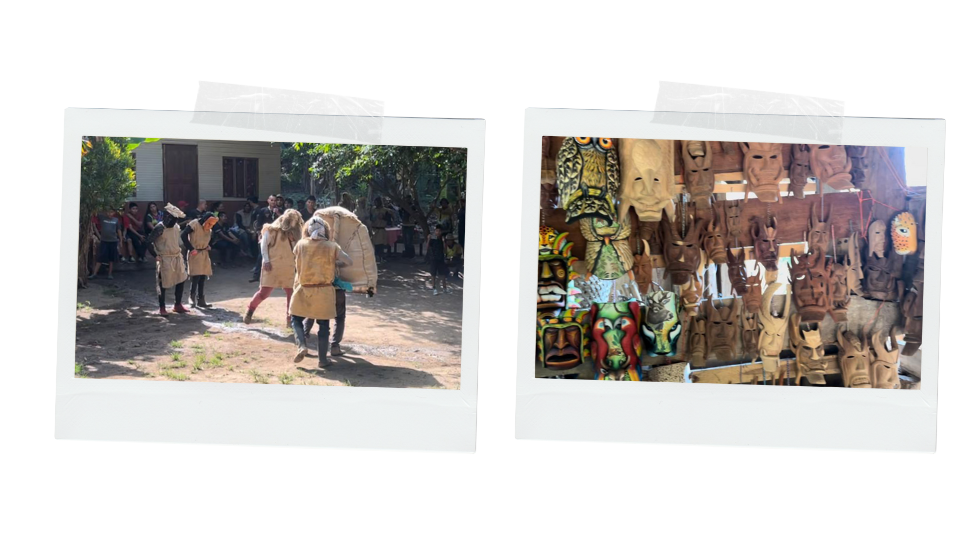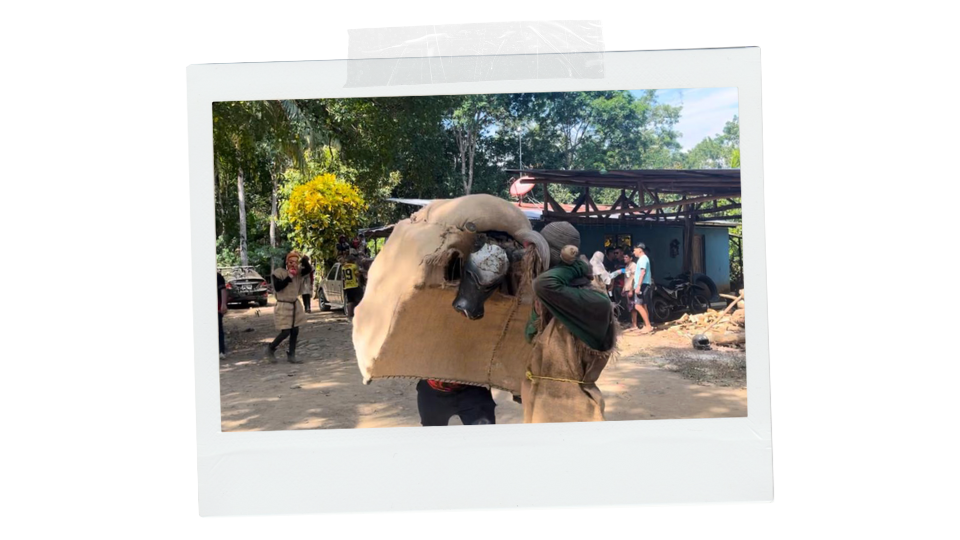El Baile de los Diablitos
Recently, I was blessed with the opportunity to enjoy a very unique cultural experience in Costa Rica. This past Saturday, I took a bus to Buenos Aires amidst the humid summer to a dusty yet quaint village in Rey Curré. We were here to celebrate El Baile de Los Diablitos. As I stepped into the village, I was immediately greeted by the rich cultural heritage of the various native and indigenous people who called Rey Curré home. Our group was taken down to where the celebration had already been ongoing for its second day out of three, and I was enveloped in an amazing sight. Immediately, you could hear the steady beating of drums and the haunting sound of flutes, reverberating throughout the village. In front of someone’s yard, there lay a distinct sight that I never imagined I would be seeing.
Men, adorned with handcrafted masks representing spirits and demons, danced around a burlap-covered bull, mocking it and taking blows as El Toro charged them. Men would take turns in their burlap smock-type costumes, engaging in fierce battles against El Toro. As I looked on in awe, our guide explained that the men in their masks, the Diablitos, represented the cunning and skill of the indigenous people, while El Toro symbolized the Spanish conquistadors. Each mock battle represented the defiance of the native people against their historical invaders. People tumbled, dust was thrown in the air, peoples’ masks fell off, and loud cries of battle rung out throughout. Drawn in, this intricate dance of playful taunts and symbolic defiance was a powerful representation of the unyielding spirit of the natives. Under the blistering sun, these people dressed in burlap persevered in this ancient tradition. Their unique masks catching the glint of the sun’s rays, a beautiful showcase of the people’s artisanal skills. Each mask had a different face telling a different story. Soon, the group moved to another house to perform the same ritualistic dance.
 As our group walked from house to house, it was clear that every individual participating in this violent symbolic defiance of their past oppressors held great pride in themselves. It was truly inspiring to witness this annual festival for myself in person to share in the culture of these amazing individuals; however, as I continued walking, trying to survive under the sun, I noticed a particular drink being shared amongst all in gords, plastic cups, coconut shells, and any container that could hold liquid. When I asked, I learned that this was Chicha, a traditional fermented corn drink made by all households in the area. On this day, Chicha was more common than water and given out gratuitously. Onlookers and participants alike took part in Chicha. This potent brew, shared among all, was more than a refreshment; it was a symbol of unity and endurance. It seemed to fortify the dancers, connecting them to their ancestors and to each other in a bond of shared heritage. With Chicha, even the harshest blows against El Toro were shrugged off as if it was nothing with Chicha. Everyone came together to smile and experience this unique aspect of history with their Chicha in hand. Even if you did not take Chicha, it really felt like we, too, were a part of this historic fight.
As our group walked from house to house, it was clear that every individual participating in this violent symbolic defiance of their past oppressors held great pride in themselves. It was truly inspiring to witness this annual festival for myself in person to share in the culture of these amazing individuals; however, as I continued walking, trying to survive under the sun, I noticed a particular drink being shared amongst all in gords, plastic cups, coconut shells, and any container that could hold liquid. When I asked, I learned that this was Chicha, a traditional fermented corn drink made by all households in the area. On this day, Chicha was more common than water and given out gratuitously. Onlookers and participants alike took part in Chicha. This potent brew, shared among all, was more than a refreshment; it was a symbol of unity and endurance. It seemed to fortify the dancers, connecting them to their ancestors and to each other in a bond of shared heritage. With Chicha, even the harshest blows against El Toro were shrugged off as if it was nothing with Chicha. Everyone came together to smile and experience this unique aspect of history with their Chicha in hand. Even if you did not take Chicha, it really felt like we, too, were a part of this historic fight.
Eventually, the festival came to a slower pause as both participants and spectators grew weary. Soon, everyone gathered into one long line together to share food. As I ate with my companions that day, I realized that my brief experience at the festival was a profound lesson in the power of cultural preservation. The people in this village have not only maintained their traditions, but have also adapted them, ensuring their relevance and vibrancy in the modern world. In just one day at El Baile de los Diablitos, I witnessed a community’s heart and soul, its struggles, and its triumphs. This festival is more than just a tourist attraction; it’s a poignant reminder of the resilience of indigenous cultures and the importance of preserving our global heritage. As I left Rey Curré, I carried with me not just memories of a festival, but a deeper understanding of the human spirit’s capacity to endure and flourish.
El Baile de los Diablitos

Hace poco tuve la oportunidad de disfrutar de una experiencia cultural única en Costa Rica. El pasado sábado, tomé un autobús en medio del húmedo verano hasta un polvoriento pero pintoresco pueblo de Rey Curré. Estábamos aquí para celebrar El Baile de Los Diablitos. Con tan solo entrar en el pueblo, me sorprendió la rica herencia cultural de los distintos pueblos indígenas y nativos que viven en Rey Curré. Llevaron a nuestro grupo al lugar donde ya se celebraba el segundo día de los tres que duraba la fiesta, y me vi envuelto en un espectáculo asombroso. Enseguida se oyó el constante redoble de los tambores y el sonido de las flautas, que reverberaban por todo el pueblo. Frente al patio de alguien, había un escenario que nunca imaginé ver.
Los hombres, adornados con máscaras artesanales que representaban espíritus y demonios, bailaban alrededor de un toro cubierto de arpillera, burlándose de él y recibiendo golpes mientras El Toro embestía contra ellos. Los hombres se turnaban con sus disfraces de toro cubierto de arpillera, enzarzándose en feroces batallas contra El Toro. Mientras yo miraba con asombro, nuestro guía nos explicó que los hombres de las máscaras, los Diablitos, representaban la astucia y habilidad de los indígenas, mientras que El Toro simbolizaba a los conquistadores españoles. Cada simulacro de batalla representaba el desafío de los nativos contra sus invasores históricos. La gente se caía, se levantaba el polvo, se les caían las máscaras y se oían fuertes gritos de batalla. Esta intrincada danza de burlas juguetonas y desafío simbólico fue una poderosa representación del inquebrantable espíritu de los nativos. Bajo un sol abrasador, la gente vestida de arpillera perseveró en esta antigua tradición. Sus singulares máscaras captaban el resplandor de los rayos del sol, una hermosa muestra de las habilidades artesanales del pueblo. Cada máscara tenía un rostro distinto que contaba una historia diferente. Pronto, el grupo se trasladó a otra casa para realizar la misma danza ritual.

Mientras nuestro grupo caminaba de casa en casa, estaba claro que cada individuo que participaba en este violento desafío simbólico, se sentía muy orgulloso de sí mismo. Fue realmente inspirador presenciar en persona este festival y presenciar la cultura de estos increíbles individuos. Sin embargo, mientras seguía caminando, tratando de sobrevivir bajo el sol, me di cuenta de una bebida en particular que se compartía entre todos en vasos de plástico, cáscaras de coco y cualquier recipiente que pudiera contener líquido. Cuando pregunté, me enteré de que se trataba de Chicha, una bebida tradicional de maíz fermentado que se prepara en todos los hogares de la zona. Ese día, la chicha era más común que el agua y se repartía gratuitamente. Tanto los espectadores como los participantes tomaban chicha. Esta potente bebida, compartida por todos, era más que un refresco: era un símbolo de unidad y resistencia. Parecía fortalecer a los bailarines, conectándolos con sus antepasados y entre sí en un vínculo de herencia compartida. Con la Chicha, incluso los golpes más duros contra El Toro no parecían afectarles en nada. Todo el mundo se reunía para sonreír y experimentar este aspecto único de la historia con su Chicha en mano. Incluso si no tomábamos Chicha, realmente parecía que nosotros también formábamos parte de esta lucha histórica.
Con el tiempo, el festival se detuvo a medida que tanto los participantes como los espectadores se cansaban. Pronto, todos se reunieron en una larga fila para compartir comida. Mientras comía con mis compañeros ese día, me di cuenta de que mi breve experiencia en el festival era una profunda lección sobre el poder de la preservación cultural. La gente de este pueblo no sólo ha mantenido sus tradiciones, sino que las ha adaptado, asegurando su relevancia y vitalidad en el mundo moderno. En sólo un día en El Baile de los Diablitos, fui testigo del corazón y el alma de una comunidad, de sus luchas y sus triunfos. Este festival es algo más que una atracción turística: es un recordatorio conmovedor de la resistencia de las culturas indígenas y de la importancia de preservar nuestro patrimonio mundial. Cuando me marché de Rey Curré, no me llevaba sólo el recuerdo de un festival, sino una comprensión más profunda de la capacidad del espíritu humano para perdurar y florecer.
—Yao

